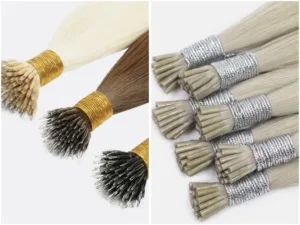Considering flat tip hair extensions for your clients or yourself? You want the truth—what they are, what they do well, and where to be cautious. This guide gives clear, manufacturer-level advice you can act on today.
Flat tip hair extensions are strand-by-strand keratin (or bead-anchored) bonds with a slim, flat profile. Pros: discreet look, precise density control, comfortable wear, possible reuse. Cons: pro installation needed, scheduled maintenance, bond-safe care, heat/oil limits.

See exactly how application works, how to prevent damage, realistic wear times, and when to choose flat tip vs U tip. You’ll get checklists to vet stylists and care steps that extend longevity.
What are flat tip hair extensions?
Short version first:
- Flat tips are single strands with a flat keratin bond or a flat plate anchored by a bead.
- The flat shape spreads pressure and keeps the profile low.
- Stylists attach them strand by strand for precise density and blending.
%[keratin flat tip hair extensions strand detail(https://placehold.co/600×400 “Keratin flat tip strand detail”)]
Flat tips sit within the keratin-bond family. The “flat” geometry matters. It creates a wider contact area than a round or V-shaped bond. This helps the bond seat close to the head and hide under layers. From a production view, I control three things:
1) Hair quality. I supply full cuticle, aligned hair for smoothness and reuse potential.
2) Bond quality. The keratin slab must be even in thickness and well-cured with no bubbles.
3) Strand weight. We offer 0.5 g, 0.7 g, and 1.0 g to match fine, medium, and thick hair needs.
In salons, you will see two attachment routes:

- Heat/ultrasonic fusion, where a tool softens the keratin and forms a thin plate.
- Flat tip bead hair extensions, where a small bead anchors the flat plate without direct heat.
Either route can be discreet when sectioning and sizing are correct.
Flat Tip Hair Extensions Pros And Cons
Here is a balanced view you can use in client consultations or purchase planning.
Pros
- Low, flat profile that lies close to the scalp.
- Strand-by-strand control for custom density, highlights, and fills.
- Good airflow between bonds; comfortable for many wearers.
- Clean keratin when produced well; neutral odor; neat look in photos.
- Flexible placement for perimeter fills, crown density, or full builds.

Cons
- Install and removal require trained hands, time, and tools.
- Maintenance is essential; late visits increase stress on natural hair.
- Daily detangling and bond-safe washing are non-negotiable.
- High heat or heavy oils near bonds shorten wear time.
- Not ideal for clients who want zero upkeep.
%[flat tip pros and cons overview(https://placehold.co/600×400 “Pros and cons overview”)]
From the factory side, three inputs decide the outcome:
- Full cuticle hair reduces friction and tangling.
- Even keratin flow stabilizes the bond.
- Clear aftercare keeps the set clean at home.
When these three align, satisfaction is high and reuse is realistic.

Flat tip hair extensions application
Below is a simple, salon-facing roadmap you can share or use to vet a new provider. I do not install hair; these are practical suggestions from a manufacturer’s angle.
Core idea
- Clean sectioning, matched strand weight, and controlled heat or bead pressure create tidy, flat bonds.
Step-by-step you can discuss with a stylist
1) Consultation
- Review lifestyle, heat styling, sport, and maintenance habits.
- Pick strand weight (0.5–1.0 g) based on hair caliber and goals.
2) Prep
- Shampoo without conditioners near roots; dry fully.
- Keep scalp product-free for bond grip.
3) Sectioning
- Work in horizontal panels with clean partings.
- Size the natural hair pick-up to match strand weight.
4) Bonding
- Fusion: soften keratin with the correct tip temperature; compress to form a slim, even plate.
- Bead: seat the flat plate with a small bead; avoid crushing the hair.
5) Placement
- Keep bonds a few millimeters off the scalp for pivot and comfort.
- Stagger positions to avoid stacking and pressure points.
6) Finish
- Blend lengths with light point cuts; confirm movement and comfort.
- Review home care and book the maintenance date.
Quality checks you can request
- Even bond thickness, no sharp edges, no residue on scalp.
- Smooth comb-through at mid-lengths and ends.
- Balanced density without heavy spots.
Are flat tip extensions damaging?
The short answer is no—when sizing, placement, maintenance, and removal are correct. Risk increases when any of those four steps slip.
Risk reducers
- Match strand weight to natural hair caliber.
- Book checks every 6–8 weeks; earlier for very fine hair.
- Detangle daily; hold bonds with your hand when brushing.
- Keep heavy oils and thick masks away from bond zones.
- Dry the bond area after workouts or swimming.
Red flags to avoid
- Bonds placed too close to the scalp; limited pivot causes pull.
- Overloaded sections (too much extension hair on too little natural hair).
- Late maintenance visits; grown-out bonds act like levers.
- Aggressive removal; picking or snapping instead of proper solvent and compression.
If a client needs a lower-commitment route, consider fewer strands, lighter weights, or a different system altogether. The safest result always follows a conservative plan.
How long do flat tip extensions last?
Think in two timelines: the bond cycle and the hair fiber life.
Bond cycle
- Typical wear per install is 8–12 weeks.
- Move-up or removal happens as growth pushes the bond down.
- Active lifestyles (gym, swim) often need earlier checks.

Hair fiber life
- With full cuticle quality and careful care, the hair can last 6–12 months or more across re-tips.
- Heat discipline and gentle products extend that life.
Care that pays off
- Sulfate-free shampoo; avoid bond zones with heavy conditioners.
- Heat protectant before hot tools; moderate temperatures.
- Silk or satin pillowcase; sleep in a loose braid or ponytail.
- Rinse after swimming; dry bonds before bed.
Plan a short mid-cycle check to catch early tangles or bond wear. Small fixes prevent big problems.
Flat tip vs U tip hair extensions
Both are keratin systems and both can look natural. The difference sits in bond geometry and handling preference.
Flat tip (pressed plate)
- Very low profile; spreads pressure over a wider surface.
- Layers cleanly in dense zones; photographs well.
- Pairs well with bead anchoring when heat avoidance is preferred.
U tip (pre-curved “U”)
- Wraps the section; some stylists like the grip feel.
- Familiar handling for experienced fusion artists.
- Slightly different removal feel—often peels in arcs.
How I suggest choosing
- Client hair caliber: finer bases often benefit from lighter, flatter bonds.
- Lifestyle and upkeep: pick the system your stylist maintains best on schedule.
- Team skill set: results follow the tool the stylist knows thoroughly.
In practice, both deliver a seamless finish when the hair, bond, and technique are right.

My opinion
From a manufacturer’s standpoint, keratin flat tip hair extensions balance a discreet look with precise control. They suit targeted fills and full transformations. They do require a trained installer, structured maintenance, and disciplined home care. When a program uses full cuticle hair, even bonds, and clear education, flat tip performs reliably and earns repeat clients.
FAQ
How many strands make a full head?
Typical ranges are 100–200 strands. Fine hair or partial fills use fewer; high-volume builds use more.
Can I color flat tip extensions?
It is possible, but it shortens life. I suggest ordering the right shade, including rooted or lowlight mixes, to avoid chemical stress.
Do flat tip bead hair extensions avoid heat?
Yes. The bead anchors the flat plate without direct heat. Sizing and neat crimping still matter.
What products should I avoid near bonds?
Heavy oils, conditioners, and masks at the bond line. Keep treatment on mid-lengths and ends.
Can I work out or swim?
Yes, with care. Rinse after chlorine or salt water and dry the bond area. Tie hair in a low braid during activity.

Conclusion
Flat tips deliver a low-profile finish and tailored placement when quality hair, skilled hands, and steady upkeep align. Choose conservative strand weights and keep appointments on time to protect natural hair and maximize results.
Hibiscus Hair Manufacturer has been dedicated to producing high-quality hair extensions for 25 years and is a recognized leader in the industry. If you are interested in finding a reliable hair extensions supplier and wholesale for your brand, please visit our website for more information:
K Tip Hair Extensions




